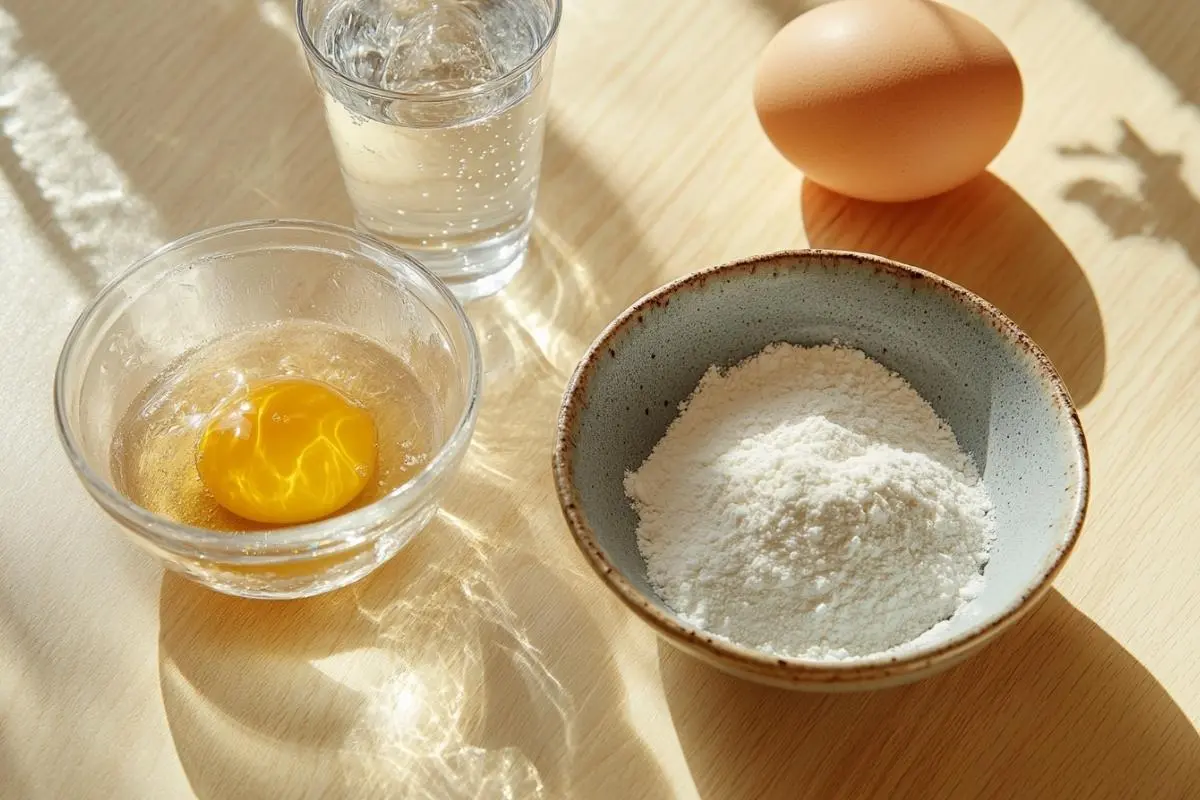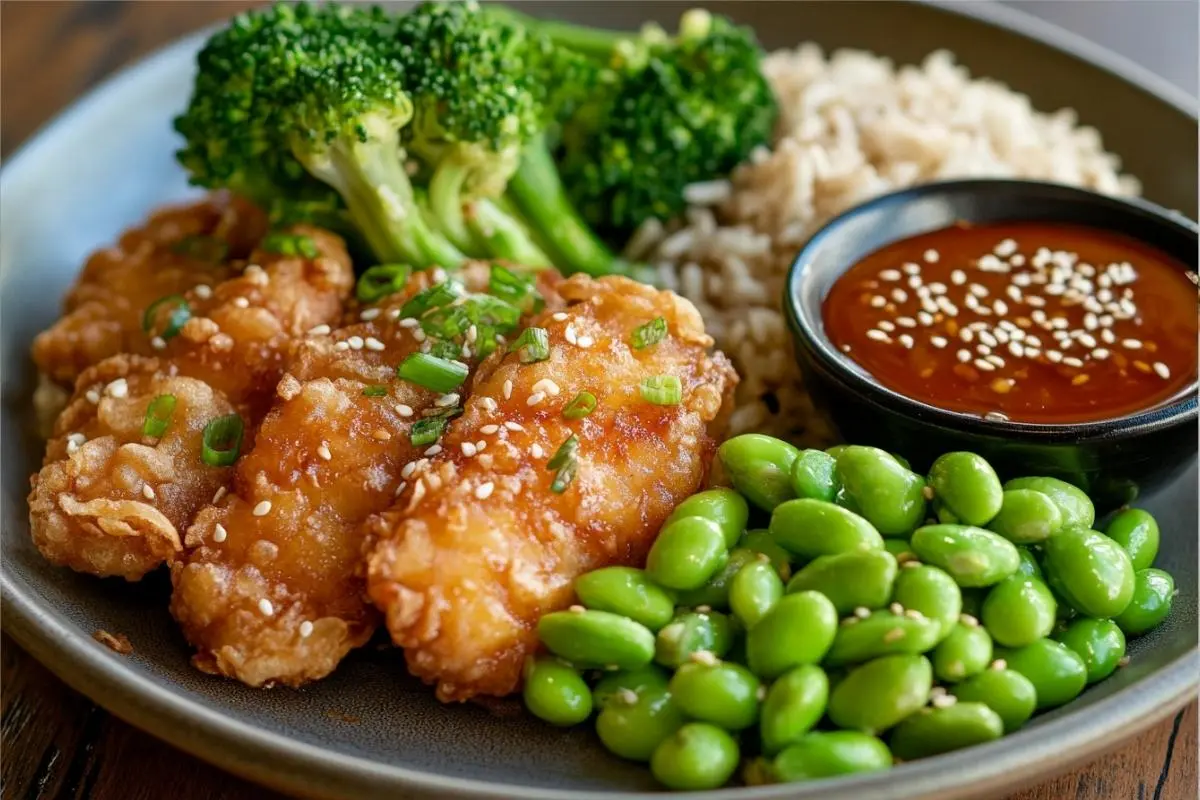Is chicken tempura healthy? This popular dish is a favorite in American cuisine, loved for its crispy texture and bold flavor. However, questions about its nutritional value, such as the calories in tempura and the health impact of deep-fried food, make many wonder if it fits into a balanced diet.
In this guide, we’ll explore tempura’s history, health effects, and nutritional profile. Plus, you’ll learn tips for making it healthier at home.
Key Takeaways
- Chicken tempura offers a complex nutritional profile that requires careful consideration
- Deep-frying impacts the overall health benefits of the dish
- Portion control is crucial when enjoying tempura
- Homemade versions can be healthier than restaurant preparations
- Balanced meal planning can include occasional tempura consumption
- Understanding cooking techniques helps make smarter dietary choices
- Nutritional content varies based on preparation method
Understanding Chicken Tempura: Traditional Preparation and Ingredients
Chicken tempura is more than just deep-fried food. It’s a culinary art that uses special ingredients to create a unique dining experience.
Key Components of Tempura Batter
Traditional tempura batter has a few key ingredients. These make the batter light and crispy:
- Wheat flour (low-protein variety)
- Cold water
- Egg
- Sparkling water or club soda (optional)

The secret to great tempura batter is not mixing too much. Too much mixing can make the batter heavy. Therefore, chefs say to keep it cold and a bit lumpy for the best taste.
Traditional Cooking Methods and Techniques
How you fry food can affect its health. Real tempura needs the right oil temperature (around 340-360°F) and quick cooking to avoid too much oil.

Looking to perfect your tempura-making skills? Follow our easy chicken tempura roll recipe for step-by-step guidance.
“The art of tempura is about creating a gossamer-thin, crisp coating that enhances without overwhelming the chicken’s natural flavor.” – Chef Hiroshi Tanaka
Cultural Significance and Origins
Tempura started with Portuguese traders in the 16th century. Thus, they brought deep-frying to Japan. Over time, this foreign method became a key part of Japanese cooking, focusing on simplicity and skill.
Learning about traditional tempura methods helps us see the balance between ingredients and cooking. As a result, this understanding makes chicken tempura a truly special food experience.
If you’re fascinated by culinary traditions, learn about another classic dish: What is Emperor’s Chicken?
Nutritional Breakdown: Calories, Fats, and Protein Content
Exploring chicken tempura nutrition shows a mix of macronutrients that needs careful thought. A typical serving has 300-400 calories. This number changes based on how it’s made and the size of the serving.
Let’s look at the main nutrients:
- Protein: About 15-20 grams per serving
- Total Fat: Around 18-25 grams
- Carbohydrates: Roughly 10-15 grams
Chicken tempura is a good choice for lean protein. The chicken itself is full of quality protein. But the crispy batter adds more calories and fat. Experts say to balance it with other foods that are full of nutrients.
“Understanding the nutritional content helps you make informed dietary choices,” says registered dietitian Sarah Miller.
Chicken tempura and grilled chicken are different. Both have protein, but chicken tempura has more calories and fat because it’s deep-fried. For those watching their health, eating it in moderation is important.
- Grilled chicken: Lower calories, less fat
- Chicken tempura: Higher calories, crispy texture
- Moderation is key for maintaining a balanced diet
How chicken tempura fits into your diet largely depends on your nutritional needs. Additionally, talking to a nutritionist can provide valuable guidance to help you make it part of a healthy meal plan.
Is Chicken Tempura Healthy? Analyzing the Facts
Daily Caloric Considerations
The calories in chicken tempura vary depending on the ingredients and frying method, with an average serving containing 300–500 calories.
- One serving has 20-30 grams of fat
- Calories change with batter thickness and oil
- It’s important to control how much you eat
Fat Content and Heart Health
Chicken tempura has protein, but deep-frying is a heart risk. The high saturated and trans fats from frying are a concern.
“Eat chicken tempura in moderation,” experts say.
Protein and Nutritional Insights
Chicken is good for protein, which helps muscles and metabolism. A serving has 15-20 grams of protein, making it good for meals.
- Lean chicken has important amino acids
- Protein keeps muscle mass
- It balances the bad of deep-frying
Eating chicken tempura wisely means knowing portion sizes. Pair it with veggies and whole grains for a balanced meal.
Health Implications of Deep-Fried Foods
Regularly eating deep-fried foods can lead to several health problems:
- Increased risk of heart disease
- Higher potential for weight gain
- Elevated cholesterol levels
- Potential inflammation in the body
Frying foods changes them in ways that can harm your health. For example, oils heated too high can create harmful substances like acrylamides and trans fats. Consequently, these can damage cells and raise your risk of chronic diseases.
“The way food is prepared can be just as important as the food itself.” – Nutrition Expert
It’s key, therefore, to find healthier alternatives to fried foods. For example, baking, grilling, or air frying can offer tasty options with fewer health risks. Moreover, these methods help keep nutrients in your food and reduce harmful compounds from frying.
On the other hand, your body reacts differently to various cooking methods. Thus, knowing the health risks of deep-fried foods helps you make better food choices. Ultimately, this supports your overall health and well-being.
Healthier Alternatives to Traditional Tempura Preparation
Craving crispy chicken tempura but worried about calories? You’re in luck! Modern cooking offers tasty, healthy tempura alternatives. These can turn this classic dish into a nutritious meal.
Air Fryer Tempura Techniques
Air fryer tempura is a game-changer for crispy texture with less oil. This method cuts down fat while keeping the crunch you love. For those looking for low-fat tempura recipes, using whole wheat flour or cornstarch for a lighter batter is another great way to reduce calories while keeping the dish delicious.

- Preheat your air fryer to 375°F
- Use a light, thin batter for best results
- Spray chicken pieces with minimal cooking spray
- Cook in small batches for even crispiness
Modified Batter Recipes
Start making low-fat tempura by changing your batter. Try these healthy options:
- Whole wheat flour instead of white flour
- Sparkling water for lighter texture
- Add ground flaxseed for extra nutrition
- Use cornstarch for crispiness without excess calories
Cooking Oil Alternatives
“The right oil can transform your tempura from indulgent to nutritious,” says Chef Keiko Tanaka, nutrition expert.
Choose heart-healthy oils for flavor and wellness. For instance, coconut oil, avocado oil, and olive oil are great alternatives to deep-frying.
Moreover, with these strategies, you can enjoy chicken tempura that’s both delicious and healthy. Therefore, your taste buds and body will undoubtedly appreciate it!
Incorporating Chicken Tempura into a Balanced Diet
Chicken tempura, therefore, can be part of a healthy lifestyle with mindful eating and balanced meal planning. In addition, moderation and portion control are key to ensuring you enjoy this crispy delight without overindulging.
Smart Portion Control
Enjoying chicken tempura doesn’t mean giving up on healthy eating. Aim for 3-4 pieces per serving to keep calories in check. Nutritionists suggest filling half your plate with vegetables to ensure a nutrient-rich, balanced meal.
“Mindful eating is about quality, not quantity.” – Nutrition Experts
Complementary Side Dishes
Pairing chicken tempura with the right sides makes it a healthier option:
- Steamed edamame for plant-based protein
- Mixed green salad with a light dressing
- Roasted vegetable mix for added vitamins
- Miso soup to round out the meal

Using small plates can naturally limit portion sizes, and lighter dipping sauces reduce unnecessary sodium and calories.
“Balance is not something you find, it’s something you create.” – Unknown
By following these tips, you can make chicken tempura a regular yet mindful part of your diet. Enjoy the crispy flavor while meeting your health goals!
Common Misconceptions About Tempura and Health
Many think tempura is bad for you, but it’s not that simple. Deep-fried foods get a bad rap, but tempura is different. It’s important to look beyond what we think we know.
“Not all tempura is created equal” – Culinary Nutrition Expert
Let’s debunk some common myths about tempura:
- Myth: Tempura is always extremely unhealthy.
- Fact: Chicken tempura can actually provide protein and essential nutrients when prepared carefully.
- Myth: Deep-frying completely destroys nutritional value.
- Fact: While excessive oil can reduce health benefits, moderate tempura consumption can still be part of a balanced diet.
- Myth: All tempura batters are the same.
- Fact: Different batter recipes can significantly impact the chicken tempura nutrition profile. Using lighter, whole-grain batters can make tempura a healthier choice.
Understanding portion control and preparation methods is key. Chicken tempura health benefits come from using high-quality ingredients and minimal oil. Modern cooking techniques like air frying can also cut down on fat.
Smart diners make informed choices when enjoying tempura. By picking lean chicken, using lighter batters, and controlling portions, you can enjoy it without sacrificing your health goals.
Tips for Creating Healthier Homemade Chicken Tempura
Making tasty low-fat tempura at home is easy. Just use the right techniques and ingredients. You can make healthier chicken tempura that’s good for you and tastes great.
Smart Ingredient Selection
Choosing the right ingredients is key for healthier chicken tempura. Here are some important picks:
- Opt for lean chicken breast instead of dark meat
- Use whole wheat or almond flour for a nutritious batter
- Select high-quality, heart-healthy oils like avocado or olive oil
- Incorporate sparkling water for a lighter, crispier coating
Preparation Techniques for Healthier Results
Your cooking method greatly affects the healthiness of chicken tempura. Here are some tips for healthier recipes:
- Use an air fryer to reduce oil consumption
- Pat chicken dry to minimize excess moisture
- Create a thin, light batter to reduce calorie density
- Cook at optimal temperatures to prevent oil absorption
“Healthy cooking is about smart choices, not sacrifice” – Nutrition experts recommend focusing on technique and ingredients.
By following these tips, you can enjoy a guilt-free version of this classic dish. It won’t sacrifice flavor or texture.
Conclusion
Learning about chicken tempura is more than just enjoying a tasty meal. Moreover, you now know how to plan your meals with this Japanese dish in mind. This way, you can enjoy the crispy texture and flavor while keeping your diet balanced.
In addition, changing how you make chicken tempura can be a game-changer. By using air fryers and choosing lean proteins, you can enjoy this dish without harming your health. The secret, however, is to be mindful and not overdo it.
For anyone wondering, Is chicken tempura healthy?, it can indeed be part of your diet if eaten wisely. Therefore, choose the best ingredients, watch your portion sizes, and try healthier cooking methods. These steps will help you enjoy tempura’s rich flavors while staying healthy.
FAQ
Is chicken tempura considered a healthy food option?
Chicken tempura isn’t usually seen as a healthy choice because it’s deep-fried. It does have protein, but the frying adds a lot of calories and fat. To make it healthier, try air frying or baking instead.
How many calories are typically in a serving of chicken tempura?
A serving of chicken tempura can have 300-500 calories. This depends on the size and how it’s made. The crispy batter and frying make it high in calories, so enjoy it in moderation.
Can I make chicken tempura healthier at home?
Yes, you can! Use lean chicken breast and a lighter batter made with whole wheat flour. Try air frying instead of deep-frying. Choose heart-healthy oils and control your portions for a healthier dish.
What are the main nutritional benefits of chicken tempura?
Chicken tempura is high in protein, which is good for your body. It also has vitamins like B6 and B12, and minerals like zinc and selenium. But, the deep-frying adds a lot of fat and calories.
How often should I eat chicken tempura if I’m trying to maintain a healthy diet?
If you’re watching your diet, eat chicken tempura only occasionally. Aim for 1-2 small servings a month. Make sure to eat lots of veggies, lean proteins, and whole grains to balance it out.
What are some healthy alternatives to traditional tempura?
Try baked or air-fried tempura, or grilled chicken with a light coating. Use batters made from almond flour, chickpea flour, or panko breadcrumbs for fewer calories and more nutrients.
Does the type of oil used in tempura make a difference in its healthiness?
Yes, the oil used makes a big difference. Choose heart-healthy oils like olive or avocado oil. They’re better for you than vegetable or canola oils, which have more harmful fats.
Can people with dietary restrictions enjoy chicken tempura?
Yes, with some changes! For gluten-free diets, use gluten-free flours. For low-sodium diets, use low-sodium batter and sauces. Always check ingredients and make homemade versions to meet dietary needs.

